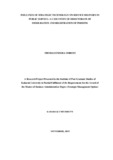| dc.description.abstract | Service delivery is the main mandate of the public sector and efficiency is critical to service delivery. However, the public sector has experienced several challenges in service delivery provision that impact the quality, timeliness and costs of these services. In the Directorate of Immigration and Registration of Persons (DIRP),consequences for poor service delivery includes lack of adequate access to documents such as national identity cards, birth and death certificates. Consequently, the public sector in Kenya has been making substantial investment in strategic technology to improve its service delivery capability. However, how this strategic technology improves service delivery function remains a key question given the challenges the DIRP. This study, therefore, sought to examine the influence of application of strategic technology on service delivery at DIRP. Amongst the aspects of strategic technology that were examined include the influences of records management aspects, proficiency of technology usage, ease of use of strategic technology, and one-stop model aspects of strategic technology on service delivery. This study used correlation research design and targeted the DIRP in Nairobi National Headquarters. The accessible population comprised all the 1059 employees of the directorate working at the head office distributed amongst diverse service departments. From these, Nassiuma‘s formula was applied to obtain a sample size of 91 respondents. This study used proportionate stratified sampling method. They used copies of a pre-tested structured questionnaire to collect data. Data was analyzed using t-test, f-test, chi squares, correlations and multiple linear regressions. Through the findings, the study established that proficiency of strategic technology usage (β = 0.161, p < 0.05), ease of use of strategic technology (β = 0.407, p < 0.05) and the onestop-model (β = 0.279, p < 0.05) significantly affected service delivery in the Directorate of Immigration. The ease of use of strategic technology was the most influential variable while proficiency was the least influential variable influencing service delivery at the Directorate. However, the application of strategic technology to records management was not found to significantly influence service delivery in the Directorate (β = -0.055, p ˃ 0.522). The study, therefore, recommends that the protocols for retrieval of information through the use of digital record management systems should be made easy for the staffs in the Directorate. The management of the Directorate should also put more emphasis on skills upgrading through trainings and workshops to ensure that skills transfer happen rapidly and that emerging issues and challenges are broadly addressed at this point. The study further recommends that the Directorate should make provisions for the users to remark on the system through frequently asked questions (FAQ) appendage. Finally, it is recommended that the Directorate and other line government agencies should emphasize the fast tracking of digitalization of personal records and information so as to reduce the levels of paperwork needed for immigration purposes and make the one-stop model a better customer service reality. | en_US |

